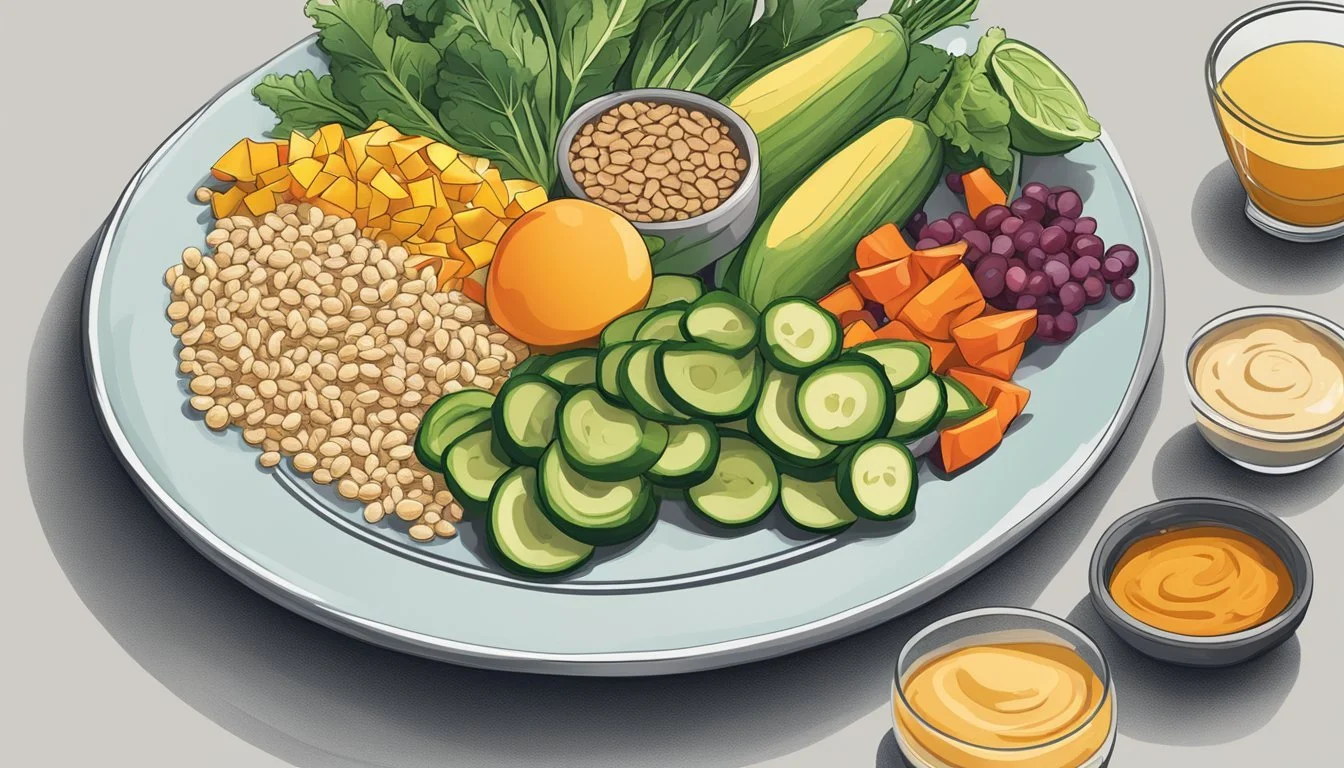Delicious Vegetarian Lunch Ideas for Diabetics: Tasty and Blood Sugar-Friendly
Managing diabetes while following a vegetarian diet can be both delicious and nutritious. Vegetarian lunch options offer a wealth of possibilities for those looking to maintain stable blood sugar levels and support their overall health. By focusing on nutrient-dense plant-based foods, individuals with diabetes can create satisfying meals that provide essential vitamins, minerals, and fiber while keeping carbohydrate intake in check.
Vegetarian lunches for diabetes management can incorporate a variety of ingredients such as leafy greens, whole grains, legumes, nuts, and seeds. These foods offer healthy fats, complex carbohydrates, and plant-based proteins that help regulate blood sugar and promote satiety. Colorful salads, hearty grain bowls, and veggie-packed wraps are just a few examples of the diverse and flavorful options available to vegetarians with diabetes.
Understanding Diabetes and Vegetarian Diets
Vegetarian diets can offer several advantages for managing diabetes. These eating patterns typically emphasize nutrient-dense foods that help regulate blood sugar levels.
Benefits of a Vegetarian Diet for Diabetes
Vegetarian diets often lead to better blood sugar control in people with diabetes. They're rich in fiber from vegetables, fruits, whole grains, and legumes, which slows carbohydrate absorption and prevents blood sugar spikes.
Plant-based diets are generally lower in saturated fat and calories, promoting weight loss and improved insulin sensitivity. This is especially beneficial for those with Type 2 diabetes.
Vegetarian meals packed with beans, lentils, and soy products provide ample protein without the saturated fat found in many animal products. These foods have a low glycemic index, helping maintain stable blood sugar levels.
Key Nutrients in a Diabetes-Friendly Vegetarian Diet
A well-planned vegetarian diet ensures adequate intake of essential nutrients for diabetes management. Protein from plant sources like beans, lentils, nuts, and seeds helps control hunger and stabilize blood sugar.
Complex carbohydrates from whole grains and vegetables provide sustained energy without causing rapid blood sugar fluctuations. These foods are also rich in fiber, further aiding blood sugar control.
Healthy fats from avocados, nuts, and olive oil support heart health and improve insulin sensitivity. Omega-3 fatty acids, found in flaxseeds and walnuts, offer anti-inflammatory benefits.
Key vitamins and minerals like B12, iron, and zinc require careful planning in vegetarian diets. Fortified foods or supplements may be necessary to meet nutritional needs.
Essential Components of Vegetarian Lunches
Vegetarian lunches for diabetes management require careful consideration of key nutrients. Balancing carbohydrates, proteins, and healthy fats helps maintain stable blood sugar levels and provides sustained energy throughout the day.
Choosing the Right Carbohydrates
Whole grains form the foundation of a nutritious vegetarian lunch for diabetics. Brown rice and quinoa are excellent options, providing complex carbohydrates that digest slowly. These grains help regulate blood sugar and offer essential fiber.
Incorporate a variety of vegetables to increase nutrient density without significantly impacting blood glucose. Leafy greens, bell peppers, and cruciferous vegetables like broccoli and cauliflower are low in carbohydrates and high in vitamins and minerals.
Limit processed carbohydrates and opt for whole fruit instead of juices. Berries, apples, and pears are good choices due to their lower glycemic index and high fiber content.
Incorporating Protein into Your Lunch
Plant-based proteins are crucial for vegetarian diabetic meals. Legumes such as lentils, chickpeas, and black beans provide both protein and fiber, helping to slow digestion and stabilize blood sugar.
Tofu and tempeh are versatile soy-based proteins that can be prepared in various ways. They're low in carbohydrates and offer complete proteins necessary for muscle maintenance and overall health.
Greek yogurt and cottage cheese are suitable for lacto-vegetarians, providing protein without added sugars. Pair these with nuts or seeds for a balanced protein source.
Adding Healthy Fats for Satiety
Healthy fats are essential for feeling satisfied after meals. Olive oil is an excellent source of monounsaturated fats and can be used in dressings or for light sautéing.
Avocados offer heart-healthy fats and can be added to salads or used as a spread. They're low in carbohydrates and high in fiber, making them ideal for blood sugar management.
Nuts and seeds like almonds, walnuts, chia seeds, and flaxseeds provide protein, healthy fats, and important minerals. Sprinkle them on salads or yogurt for added crunch and nutrition.
Vegetarian Lunch Ideas and Recipes
Vegetarian lunches can be nutritious, satisfying, and diabetes-friendly. These meals focus on plant-based proteins, complex carbohydrates, and fiber-rich ingredients to help maintain stable blood sugar levels.
High-Protein Vegetarian Lunches
Tofu and tempeh are excellent protein sources for vegetarians. Marinate tofu cubes in a low-sodium soy sauce and grill for a flavorful addition to salads or grain bowls. Tempeh can be crumbled and used as a meat substitute in tacos or wraps.
Eggs are another versatile protein option. Make a vegetable frittata with spinach, bell peppers, and a sprinkle of low-fat cheese. This dish can be prepared in advance and enjoyed cold or reheated.
Edamame is packed with protein and fiber. Add it to salads or enjoy as a snack with a light sprinkle of sea salt.
Simple and Quick Vegetarian Salads
A chickpea salad is easy to prepare and rich in protein and fiber. Mix canned chickpeas with diced cucumbers, tomatoes, and a light vinaigrette dressing.
Green salads can be elevated with protein-rich toppings. Try a vegan kale Caesar salad with tofu croutons. Massage kale with a dairy-free Caesar dressing and top with crispy baked tofu cubes.
For a heartier option, create a chopped veggie grain bowl. Combine cooked quinoa or brown rice with an assortment of raw and roasted vegetables. Drizzle with a turmeric dressing for added flavor and potential anti-inflammatory benefits.
Diabetes-Friendly Vegetarian Sandwiches
Use whole-grain bread as a base for sandwiches to increase fiber intake. Spread hummus instead of mayonnaise for a healthier fat option.
Layer sliced tomatoes, cucumber, and avocado for a refreshing and nutrient-dense filling. Add a slice of low-fat cheese for extra protein and calcium.
For a twist on the classic PB&J, try almond butter with thin apple slices on whole-grain bread. This combination provides protein, healthy fats, and complex carbohydrates.
Warm Vegetarian Lunch Bowls
Create a balanced bowl with cooked quinoa or brown rice as a base. Add roasted sweet potatoes for complex carbs and fiber.
Top with a variety of colorful vegetables like steamed broccoli, roasted bell peppers, and sautéed mushrooms. These add essential vitamins and minerals while keeping the meal low in calories.
Include a protein source such as grilled tofu, tempeh, or a hard-boiled egg. Finish with a sprinkle of seeds or a small handful of nuts for healthy fats and extra protein.
Meal-Prep Strategies for Busy Schedules
Meal prepping is a valuable tool for managing diabetes while following a vegetarian diet. It saves time and helps maintain stable blood sugar levels throughout the week.
Start by planning meals in advance. Choose recipes that incorporate a variety of vegetables, whole grains, and plant-based proteins. These ingredients provide essential nutrients and help regulate blood sugar.
Batch cooking is key. Dedicate a few hours on weekends to prepare large quantities of staple foods like quinoa, brown rice, or roasted vegetables. Store them in airtight containers for easy access during the week.
Invest in portion-controlled containers. This ensures consistent serving sizes and helps with weight management, an important factor in diabetes care.
Prep ingredients in advance:
Wash and chop vegetables
Cook and portion beans or lentils
Prepare homemade dressings or sauces
Consider assembling grab-and-go meals like overnight oats, layered salads in jars, or veggie-packed wraps. These options make it easy to stick to a diabetes-friendly meal plan, even on busy days.
Freeze extra portions for future use. This provides a backup option for days when meal prep isn't possible, helping maintain a consistent eating routine.
Remember to include a mix of complex carbohydrates, lean proteins, and healthy fats in each meal. This balanced approach supports stable blood sugar levels and keeps you feeling satisfied.
Navigating Nutritional Challenges
Vegetarians with diabetes face unique dietary considerations. Balancing nutrients and blood sugar requires careful planning and informed food choices.
Balancing Macronutrients and Blood Sugar
Glycemic Index plays a crucial role in managing blood glucose levels. Complex carbs from whole grains, legumes, and non-starchy vegetables are essential. These foods release glucose slowly, preventing sudden spikes.
Fiber-rich foods help stabilize blood sugar. Aim for 25-30 grams daily. Incorporate leafy greens, broccoli, and Brussels sprouts into meals.
Protein sources like tofu, tempeh, and lentils are vital. They provide satiety and help maintain steady glucose levels.
Healthy fats from nuts, seeds, and avocados are beneficial. They slow digestion and improve insulin sensitivity.
Vegetarian Diet and Long-Term Health
A well-planned vegetarian diet can support long-term diabetes management. It often leads to better weight control and reduced risk of cardiovascular disease.
Plant-based diets typically offer higher nutrient density. This can help prevent deficiencies common in diabetes.
The American Diabetes Association supports vegetarian diets for diabetes management. They emphasize the importance of variety and portion control.
Registered dietitians can provide personalized guidance. They help ensure nutritional needs are met while keeping blood sugar in check.
Regular monitoring of blood glucose levels is crucial. It helps individuals understand how different foods affect their body.
Support and Resources
Managing diabetes with a vegetarian diet requires guidance and ongoing education. Professional support and access to reliable information are crucial for developing effective meal plans and maintaining overall health.
Consulting with Health Professionals
Registered Dietitians specializing in diabetes care play a vital role in creating personalized vegetarian meal plans. They assess nutritional needs, recommend appropriate portion sizes, and suggest plant-based protein sources. Endocrinologists monitor blood sugar levels and adjust medications as needed. Regular check-ups with primary care physicians help track overall health and manage diabetes-related complications.
Healthcare teams may include Certified Diabetes Educators who offer practical advice on meal preparation, carbohydrate counting, and blood glucose monitoring. These professionals ensure that vegetarian diets meet all nutritional requirements while effectively managing diabetes.
Educational Materials and Support Groups
The American Diabetes Association provides comprehensive resources for vegetarians with diabetes. Their website offers meal planning tools, recipe collections, and nutritional guidelines. Local hospitals and community centers often host diabetes education classes tailored to vegetarian diets.
Online forums and social media groups connect individuals facing similar challenges. These platforms facilitate recipe sharing and provide peer support. Many organizations offer free or low-cost webinars on topics like plant-based protein sources and balancing carbohydrates in vegetarian meals.
Smartphone apps help track nutrient intake and blood sugar levels. Some apps specifically cater to vegetarians with diabetes, offering customized meal suggestions and nutritional analysis.
Adjusting Recipes for Vegan and Other Vegetarian Diets
Adapting vegetarian recipes to suit different dietary preferences requires creative ingredient substitutions and thoughtful meal planning. These adjustments can ensure nutritional balance while catering to various vegetarian eating styles.
Vegan Alternatives for Traditional Ingredients
Vegan diets exclude all animal products, necessitating clever substitutions. For dairy, plant-based milk alternatives like almond, soy, or oat milk work well in most recipes. Nutritional yeast adds a cheesy flavor to dishes without using actual cheese.
Nut butters and tahini serve as excellent replacements for butter in baking. Mashed bananas or applesauce can substitute eggs in many desserts. For savory dishes, tofu scramble makes a protein-rich alternative to egg salad.
Whole foods like lentils, beans, and quinoa provide essential nutrients and can replace meat in many recipes. These ingredients boost protein content and add texture to meals.
Adapting to Lacto-Ovo and Flexitarian Preferences
Lacto-ovo vegetarians consume dairy and eggs, offering more flexibility in recipe adaptation. Yogurt can be used in place of cream in sauces and dressings. Eggs serve as binding agents in baked goods and add protein to salads.
For flexitarians who occasionally eat meat, plant-based proteins can be substituted in familiar recipes. Mushrooms offer a meaty texture in dishes like burgers or stir-fries. Tempeh or seitan can replace chicken in sandwiches or wraps.
Experimenting with different ingredients allows for personalized meal planning. Incorporating a variety of whole grains, legumes, and vegetables ensures a balanced diet for all vegetarian preferences.






